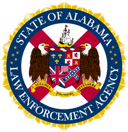Many communities rely on volunteer fire departments for their fire protection and EMS response. ALEA State Troopers often work alongside volunteer firefighters and EMS volunteers, and we appreciate the efforts of these volunteers.
Please see the below Frequently Asked Questions regarding volunteer fire and EMS personnel as to the responsibilities and legal considerations while responding to calls for service in an effort to keep them -- and the community they serve -- safe.
Frequently Asked Questions
No. Alabama State law restricts the use of emergency lights and siren to designated emergency vehicles.
Alabama State law (Section 32-5A-115, Code of Alabama 1975) states that only the Director of Public Safety, now ALEA, or police chief of an incorporated city has the authority to designate a vehicle as such.
No. Only a “publicly owned” vehicle will be considered for designation as an “emergency vehicle.”
No. While operating a privately owned vehicle, you are required to obey all laws.
State law allows emergency vehicle operators, while responding to emergency calls, to violate traffic laws ONLY while demonstrating due regard for public safety. (For example, when responding to an emergency call and you encounter a red light, you may only go through that intersection AFTER you have determined such movement can be made safely).
Yes. State law requires that an emergency vehicle have at least one lamp (red for fire/EMS, blue for police) AND an audible siren to be in compliance with the law.
Yes, you may do so as long as the vehicle is parked on the side of the road and not in motion.
No. Under Alabama law, ONLY the director of the Alabama Department of Public Safety or the chief of police of an incorporated city has the authority to designate a vehicle as an “emergency vehicle.”
Section 32-1-1.1 defines
“emergency vehicle” as:
(3) AUTHORIZED EMERGENCY VEHICLE. Such fire department vehicles, police vehicles and ambulances as are publicly owned, and such other publicly or privately owned vehicles as are designated by the Director of Public Safety or the chief of police of an incorporated city.
Section 32-5A-115
Operation of vehicles on approach of authorized emergency vehicles; signals on emergency vehicles; duty of emergency vehicle driver.
(a) Upon the immediate approach of an authorized emergency vehicle equipped with at least one lighted lamp and audible signal as is required by law, the driver of every other vehicle shall yield the right-of-way and shall immediately drive to a position parallel to, and as close as possible to, the right-hand edge or curb of the roadway clear of any intersection and shall stop and remain in such position until the authorized emergency vehicle has passed, except when otherwise directed by a police officer.
(b) This section shall not operate to relieve the driver of an authorized emergency vehicle from the duty to drive with regard for the safety of all persons using the highways.
(c) Authorized emergency vehicles shall be equipped with at least one lighted lamp exhibiting a colored light as hereinafter provided visible under normal atmospheric conditions from a distance of 500 feet to the front of such vehicle and a siren, exhaust whistle, or bell capable of giving an audible signal. The color of the lighted lamp exhibited by police vehicles may be red or blue and the color of the lighted lamp exhibited by the fire department and other authorized emergency vehicles, including ambulances, shall be red. No vehicle other than a police vehicle will use a blue light. An amber or yellow light may be installed on any vehicle or class of vehicles designated by the Director of Public Safety, but such light shall serve as a warning or caution light only, and shall not cause other vehicles to yield the right-of-way. This provision shall not operate to relieve the driver of an emergency vehicle from the duty to drive with due regard for the safety of all persons using the highway nor shall it protect the driver of any such vehicle from the consequences of an arbitrary exercise of such right-of-way.
(Acts 1980, No. 80-434, p. 604, §4-106; Acts 1981, No. 81-803, p. 1412, §1.)
For additional information, please contact Highway Patrol at 334.242.4393.
